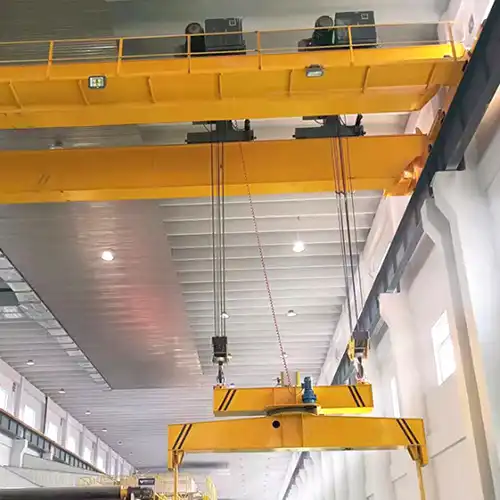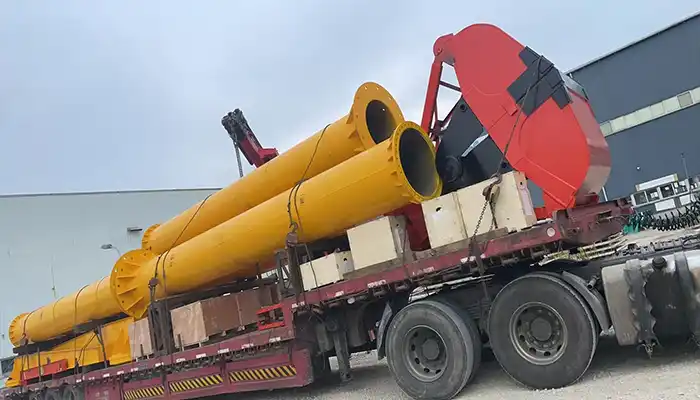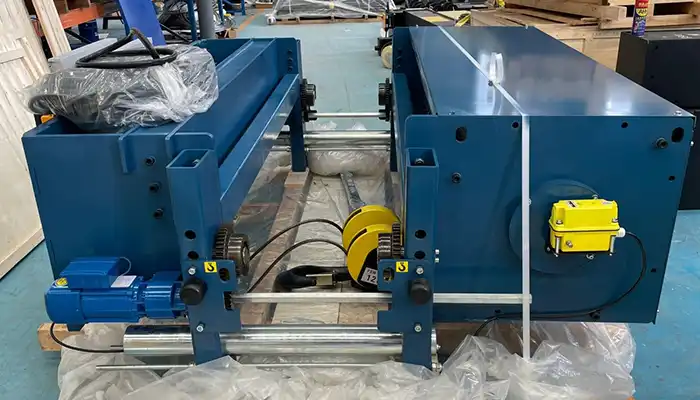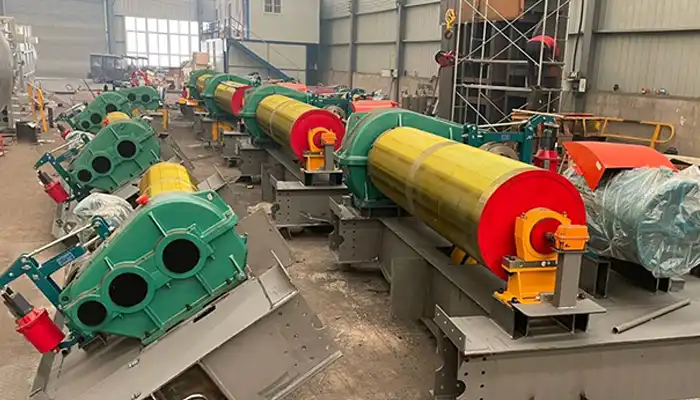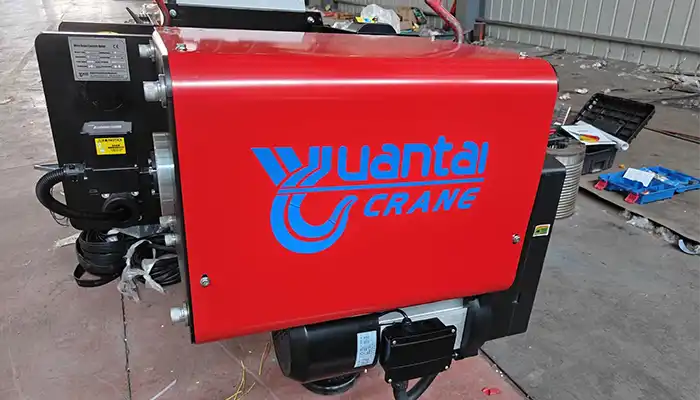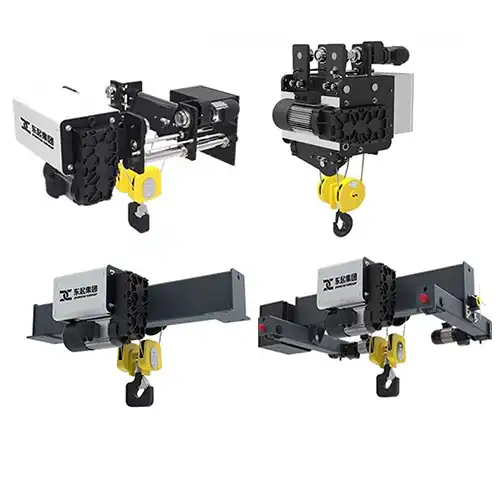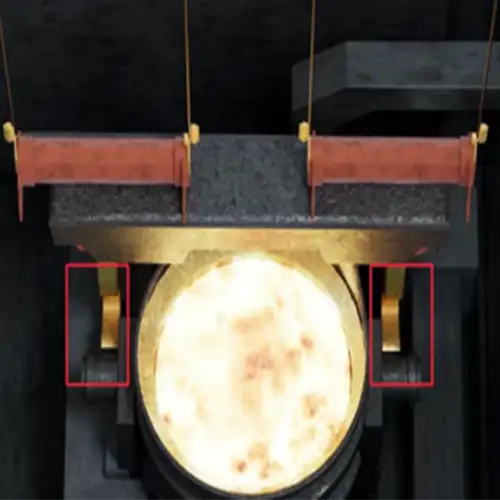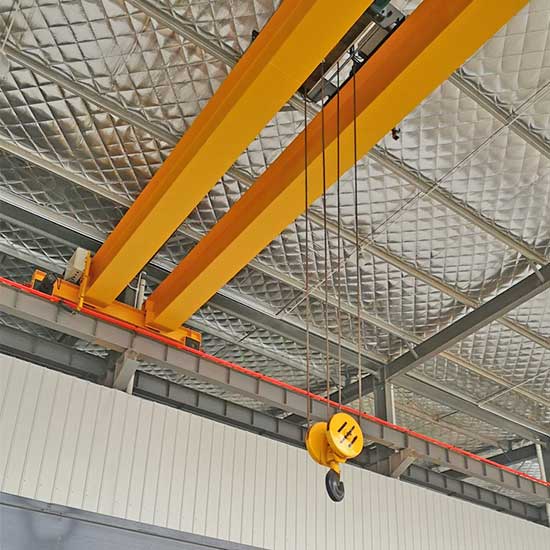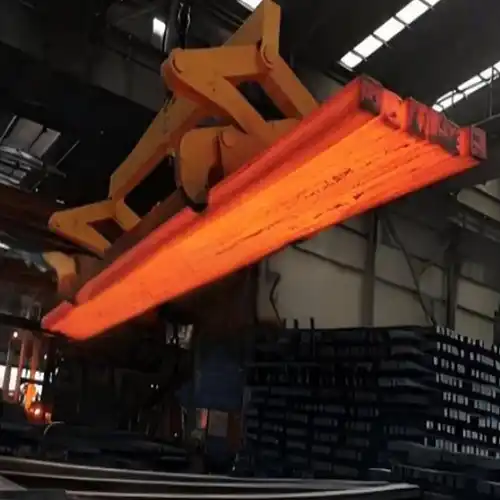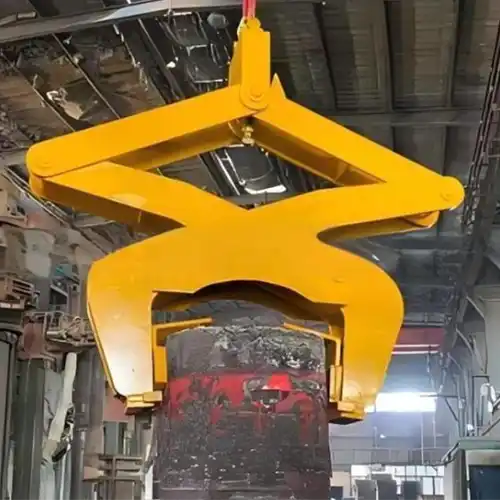20+20 Ton Overhead Crane + Duel Hoist Trolley for Billet Handling
Powerful dual lifting capacity overhead crane 20 ton + 20 ton designed for efficient billet lifting, transportation & positioning in steel mill operations.
Category: Steel
Your Trusted Steel Mill Overhead Crane Manufacturer & Supplier
20+20 Ton Overhead Crane + Duel Hoist Trolley for Billet Handling
Good Price, Billet Handling Overhead Crane for Billet Workshops
Powerful dual lifting capacity overhead crane designed for efficient billet lifting, transportation, and positioning in steel mill operations.
Billet Handling Overhead Cranes
Overview of the Steel Mill Industry
Steel mills are a cornerstone of modern manufacturing, producing materials essential for infrastructure, transportation, and machinery. A crucial part of this production is the handling of raw materials like billets, which are the building blocks of various steel products.
- Billets are heavy and hot, making their movement in the mill challenging.
- Efficient handling is vital to prevent delays and ensure safety during production.
- Overhead cranes with double hoist trolleys are used to move materials quickly, safely, and accurately, allowing smooth transitions between different production stages.
Without efficient material handling, steel mills can face significant delays and increased risks. The proper handling system is critical for maintaining a steady production flow.

Purpose of the Case Study
This case study focuses on the 20+20 Ton Overhead Crane designed for billet handling in steel mills.
- Key function: Lifting, transporting, and positioning steel billets for further processing.
- Dual lifting capacity: The crane has a 20-ton lifting capacity on each of its two hoists, allowing it to lift multiple billets at once.
By exploring the crane's design and usage, we aim to understand how it improves handling efficiency and supports the steel mill's operations. The crane's ability to manage more than one billet at a time significantly speeds up the process and reduces labor costs, boosting overall productivity in the steel mill. This allows billets to move faster through the production line, ensuring quicker transformation into finished products and helping the mill meet production targets.
Background
Challenges in Billet Handling
Handling billets in a steel mill is no easy task. These billets are heavy, hot, and need precise movement to ensure safety and efficiency. The challenges involved include:
- Weight and Heat: Billets are typically around 6 to 10 tons each, and when they are hot (at temperatures over 1000°C), they become even more difficult to manage. Handling such high-temperature materials increases the risk of accidents and equipment damage.
- Precision: Moving billets accurately is crucial. Any misalignment can cause delays or even accidents. A small mistake can lead to improper positioning during processing, affecting the quality of the final steel products.
- Time: The need for fast, continuous handling is critical to maintaining production schedules. Any delay in moving billets to the next stage of processing can halt the production line, leading to inefficiency and potential financial losses.
Traditional Methods vs. Modern Lifting Solutions
In traditional steel mills, handling billets was done manually or with basic lifting systems. While functional, these methods had several limitations:
- Manual labor: Using cranes with basic hoists required a lot of manual work, which increased the risk of human error and injuries.
- Limited capacity: Traditional cranes had a limited lifting capacity, meaning billets had to be handled one at a time. This slowed down production and reduced the mill's overall output.
Modern lifting solutions, like the 20+20 Ton Overhead Crane, provide greater flexibility and efficiency:
- Dual lifting capacity: The crane can lift two separate loads of 20 tons each, which allows for handling multiple billets at once, speeding up the overall process.
- Advanced control systems: Modern cranes are equipped with automated control systems, reducing human error and improving precision.
Need for Dual Capacity Cranes
In steel mills, time is critical. The ability to handle multiple billets at once has a direct impact on production speed and efficiency. This is where dual capacity cranes, like the 20+20 Ton Overhead Crane, come in:
- Handling multiple billets simultaneously: With a 20-ton capacity on each hoist, the crane can lift two billets at once, significantly reducing handling time. This allows workers to focus on other tasks and ensures the billets move faster to the next stage of production.
- Flexibility: These cranes can adapt to different sizes and weights of billets, making them versatile tools in the steel mill environment.

Impact of Handling Flexibility on Production Speed and Efficiency
The flexibility of dual capacity cranes translates into tangible improvements in production speed:
- Faster handling: The crane's ability to lift multiple billets cuts down the time spent moving each individual billet. This, in turn, speeds up the entire production process.
- Increased throughput: With more billets being moved at once, mills can increase the volume of steel processed per day, leading to higher productivity and better profitability.
- Optimized workflow: The crane's ability to handle multiple billets at once helps maintain a continuous flow of materials throughout the mill, reducing bottlenecks and downtime.
In summary, the dual capacity crane offers a solution to many of the challenges posed by traditional billet handling methods. It not only improves safety and precision but also enhances the overall efficiency of the steel mill's operations.
Technical Specifications of the 20+20 Ton Overhead Crane
Crane Design
The 20+20 Ton Overhead Crane is typically designed as a double girder crane, which provides superior strength and stability compared to single girder cranes.
- Double Girder Design: This design features two parallel girders, supporting the hoisting mechanism, offering increased lifting capacity and better load distribution. The double girder structure also allows for larger spans, making it ideal for moving heavy billets across the mill.
- Lifting Capacity: The crane has a dual 20-ton lifting capacity, meaning it can lift two separate loads of 20 tons each. This dual capacity allows for greater flexibility in handling multiple billets simultaneously, reducing time spent on lifting and transporting each individual billet.
Key Features
Hoisting Mechanism: The crane uses a low headroom electric hoist trolley with European style design provides smooth, powerful lifting for heavy billets, while the electric system controls the movement and precision. This advanced overhead crane approach balances power and control, making the billet crane versatile in a demanding environment.
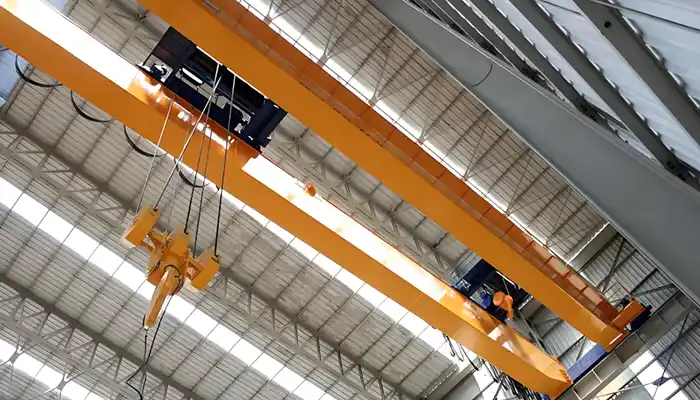

Safety Features: Safety is a primary concern when handling heavy and hot billets. The crane is equipped with several safety features to ensure both operator and equipment protection:
- Limit switches prevent the crane from moving beyond safe operating boundaries, avoiding accidental damage to the crane or surrounding structures.
- Overload protection ensures that the crane does not lift more than its maximum capacity, preventing accidents and maintaining the integrity of the crane.
- Emergency stop systems are in place to halt crane movement instantly in case of a malfunction, further ensuring the safety of the operators.
Control Systems: The crane can be operated through different control systems, depending on the level of automation:
- Manual control allows operators to directly control crane movements.
- Remote control offers flexibility, allowing operators to manage the crane from a safe distance.
- Automated control can be integrated to make the crane's movements more precise and reduce human error, improving efficiency and safety.
Materials and Construction
The crane is built to withstand the harsh conditions of a steel mill, where extreme temperatures, dust, and heavy-duty operations are the norm.
- Structural Materials: The crane frame is typically made of high-strength steel or alloy steel, capable of withstanding the heavy loads and intense heat in the mill environment. The components are treated to resist corrosion, extending the crane's lifespan even in high-moisture or chemically aggressive areas.
- Durability: The crane is designed for high durability. It undergoes rigorous stress testing and quality control checks to ensure it can handle continuous, demanding use in the mill. Components like the hoists, gears, and motors are built with robust materials to minimize wear and tear.
Maintenance Considerations
Regular maintenance is crucial to keeping the crane in top working condition:
- Routine Inspections: Scheduled inspections of key components (e.g., hoists, electrical systems, and safety features) are necessary to detect any signs of wear or malfunction early. Preventive maintenance helps avoid unexpected breakdowns and downtime.
- Easy Maintenance Access: The crane is designed with easy access points for maintenance personnel. This reduces downtime when repairs or inspections are needed and ensures that routine maintenance tasks are completed on time.
- Long-Lasting Parts: The use of durable materials and high-quality components helps minimize the frequency of major repairs, making the crane cost-effective in the long run. Proper care can significantly extend the operational life of the crane.
In conclusion, the 20+20 Ton Overhead Crane combines a solid double girder design, advanced safety features, and hybrid lifting systems to meet the demanding needs of steel mills. Its robust construction and high durability ensure it can handle the harsh working conditions of the mill, while its dual capacity and advanced control systems enhance operational efficiency and safety.
Application of the Double Hoist Crane in Billet Handling
Operational Workflow
The 20+20 Ton Overhead Crane plays a vital role in the billet handling process within the steel mill. It is involved in several key steps:
- Billet Lifting: The crane lifts heavy billets from their storage area or directly from the casting line. Using its dual 20-ton capacity, the crane can easily handle large billets, which are often too heavy for traditional lifting systems.
- Transporting: After lifting, the crane transports the billets across the mill. It uses its high lifting capacity and strong structural design to move billets across long spans, navigating different workstations with precision.
- Positioning: Once the billets reach the required processing area, the crane positions them accurately. This step is crucial, as billets need to be placed precisely for further processing, such as rolling into bars or rods. The crane's precision control systems ensure that the billets are positioned correctly, reducing errors in the subsequent stages.
The crane is fully integrated into the steel mill's overall production line. After billets are lifted and positioned by the crane, they are passed on to rolling mills or other processing machines. The overhead crane's speed and reliability contribute directly to the smooth flow of the production line, preventing bottlenecks that could slow down the process.
Handling Multiple Billets
One of the most significant advantages of the 20+20 Ton Overhead Crane is its dual lifting capacity, which allows it to handle multiple billets at once. Here's how this benefits the billet handling process:
- Dual Lifting Capability: With a 20-ton lifting capacity on each hoist, the crane can lift two billets at the same time, effectively doubling the crane's productivity. This is particularly beneficial when multiple billets need to be moved to the same processing area. Instead of making multiple trips for each billet, the crane can quickly and efficiently move several at once, cutting down the overall time spent on lifting and transport.
- Increased Speed and Reduced Downtime: By handling multiple billets simultaneously, the crane reduces the time between lifting, transporting, and positioning. This means less downtime for workers and more billets processed in a shorter amount of time. Steel mills are able to maintain a consistent, high-paced workflow, ensuring that the production line operates efficiently.
Case Examples or Scenarios
The dual 20-ton capacity crane proves especially beneficial in several common mill scenarios:
- High-Volume Production: In mills that produce large quantities of steel, handling multiple billets at once helps meet the high demand. For example, during peak production periods, the crane can handle large volumes of billets simultaneously, allowing the mill to keep up with tight schedules.
- Batch Processing: When a batch of billets needs to be moved to the rolling mill, the crane's dual capacity ensures that several billets can be transported in a single trip, rather than requiring multiple trips. This not only speeds up the process but also optimizes the space and resources in the mill, improving throughput.
- High-Temperature Handling: When billets are freshly cast, they are extremely hot. Handling multiple billets at once allows the crane to move large quantities of billets quickly, reducing the exposure time to high temperatures for both the billets and the crane operators. This improves safety and minimizes heat-related delays.
Overall, the 20+20 Ton Overhead Crane's ability to handle multiple billets at once increases both speed and efficiency in billet handling. This, in turn, leads to better overall mill productivity, reduced labor costs, and smoother integration into the steel mill's production process.
Benefits of the 20+20 Ton Overhead Crane
Increased Efficiency
The 20+20 Ton Overhead Crane significantly reduces handling time for billets, which directly impacts the overall production efficiency.
- Reduced Handling Time: With the dual 20-ton lifting capacity, the crane can transport and position multiple billets simultaneously. This eliminates the need for multiple lifts, saving valuable time. Instead of waiting for each billet to be lifted one at a time, the crane can move billets in parallel, speeding up the process.
- Improvement in Workflow: The crane's ability to handle multiple billets also helps streamline the mill's production line. Less time is spent on lifting and transporting materials, leading to a more continuous flow of work. This allows other processes, such as rolling and further shaping of billets, to proceed without interruption, keeping the entire production cycle efficient.
- Increased Production Rates: As billets are moved more quickly and accurately, the overall throughput of the mill increases. The faster the billets reach the next stage, the more products can be processed per hour, improving production rates and meeting higher demand.
Safety Enhancements
The crane's advanced safety features contribute significantly to safer operations in a high-risk, hazardous environment.
- Advanced Safety Features: The crane is equipped with features such as limit switches to prevent over-travel, overload protection to avoid lifting more than its rated capacity, and emergency stop systems for quick halts in case of malfunction. These mechanisms reduce the risk of accidents caused by equipment failure or operational errors.
- Impact on Reducing Workplace Accidents: By ensuring the crane operates within safe parameters, the risk of accidents is significantly reduced. The remote control system allows operators to manage the crane from a safe distance, reducing exposure to potential hazards. Additionally, the automated control systems further minimize human error, ensuring more precise and safer movements.
- Improving Operator Safety: The ability to handle billets more efficiently with minimal manual intervention means operators are less likely to be exposed to the high heat or heavy lifting associated with billet handling. This is key in improving overall workplace safety and protecting the health of the workforce.
Flexibility and Versatility
The crane's versatility and adaptability make it ideal for various billet sizes and weights.
- Handling a Range of Sizes and Weights: The 20+20 Ton Overhead Crane is capable of handling a wide range of billet sizes and weights. Whether dealing with light or heavy billets, the crane's dual lifting capacity ensures it can adjust to the required load, maintaining the same level of efficiency and safety.
- Quick Adaptability to Various Billet-Processing Stages: The crane can move billets through various stages of processing, such as moving billets to rolling mills or positioning them for other shaping processes. Its ability to lift multiple billets simultaneously makes it ideal for managing bulk quantities, which is essential in a high-volume production environment. Whether billets are being processed into bars, rods, or other shapes, the crane can adapt quickly to the changing requirements of the mill.
Cost-Effectiveness
The 20+20 Ton Overhead Crane offers long-term financial benefits, making it a cost-effective choice for steel mills.
- Long-Term Savings: By reducing the need for manual labor and improving lifting efficiency, the crane helps lower labor costs. Additionally, its advanced design and durable materials reduce the frequency of repairs, leading to savings in maintenance. The crane's reliable operation minimizes unexpected downtime, ensuring that production is not interrupted.
- Increased Throughput Leading to Better Profitability: With faster billet handling, more billets can be processed per day, leading to an increase in overall production output. Higher production rates directly contribute to better profitability, as the mill can meet higher customer demand without sacrificing quality or efficiency.
In summary, the 20+20 Ton Overhead Crane enhances a steel mill's operations by improving efficiency, increasing safety, offering versatility, and being cost-effective in the long run. These benefits not only optimize production rates but also ensure a safer working environment for operators and more profitable mill operations.
Challenges and Solutions
Operational and Environmental Factors
Steel mills are harsh environments, with extreme temperatures, heavy-duty operations, and a lot of dust and debris. These factors can put significant stress on equipment like overhead cranes. Some of the main challenges include:
- Extreme Temperatures: The heat from handling hot billets can affect the crane's mechanical systems, particularly the hoisting equipment and control systems. High temperatures can cause wear on parts and reduce the efficiency of certain components.
- Dust and Debris: Dust and debris in the mill environment can clog or damage mechanical parts, especially in the crane's electrical systems, hoists, and motors.
- Heavy-Duty Operations: The crane operates under intense loads regularly, lifting several tons of material at once. This heavy use can lead to mechanical strain and component wear.
Solution: To combat these challenges, the crane is built using heat-resistant and durable materials. Components are designed to withstand high temperatures, and the crane's electrical systems are shielded to prevent dust and debris buildup. Additionally, the crane's maintenance intervals are designed with these environmental factors in mind to ensure it operates smoothly under harsh conditions.
Maintenance and Longevity
High-load cranes in steel mills face significant wear and tear, so maintenance is a key concern. Challenges include:
- Regular Wear and Tear: Constant operation under heavy loads can lead to wear on components like hoists, gears, and motors, requiring timely maintenance to keep the crane operational.
- Lubrication and Cooling: High temperatures and heavy-duty operations make it necessary to use high-quality lubricants and cooling systems to keep the crane's moving parts from overheating or becoming damaged.
Solution: The crane is designed with durable, long-lasting components that can withstand the heavy loads and harsh conditions. Scheduled maintenance is a key part of the operation, ensuring that any signs of wear are caught early. Regular inspections and timely lubrication help maintain the crane's efficiency and extend its lifespan. Additionally, high-quality materials are used to minimize downtime and reduce the need for frequent repairs.
Operator Training
The dual-lifting capabilities of the crane add a layer of complexity that requires properly trained operators to handle safely and effectively.
- Handling Dual 20-Ton Lifting Capacity: Operators must be trained to manage the lifting and positioning of multiple billets simultaneously. Without proper training, there is a risk of overloading or misalignment, which could lead to accidents or inefficiencies.
Solution: Comprehensive operator training programs are crucial. Training focuses on safety protocols, the proper use of the crane's dual lifting capabilities, and how to respond to emergencies. By ensuring operators are well-versed in the crane's features, steel mills can enhance safety and efficiency.
Impact on Steel Mill Operations
Production Improvements
The 20+20 Ton Overhead Crane has a direct impact on the efficiency of steel mill operations, leading to measurable improvements:
- Reduced Handling Time: With the ability to lift multiple billets at once, the crane significantly reduces the time spent lifting and positioning individual billets. This faster material handling allows the mill to maintain a smooth production flow and minimize downtime.
- Increased Throughput: The crane's efficiency in handling billets results in an increase in overall throughput. By moving multiple billets simultaneously, the crane speeds up the process, enabling the mill to handle higher volumes of material in less time.
For example, in a mill that processes an average of 500 billets per day, the crane's dual lifting system could increase throughput by 20-30%, translating to an additional 100-150 billets processed daily, improving production rates significantly.
Impact on Safety and Reliability
The crane enhances the mill's safety and reliability in several ways:
- Advanced Safety Features: The inclusion of limit switches, overload protection, and emergency stop systems ensures that the crane operates within safe parameters, reducing the risk of accidents caused by equipment failure or human error.
- Operator Protection: By using remote or automated control systems, operators are kept at a safe distance from the crane's hazardous environment, minimizing exposure to hot materials or heavy lifting risks. The crane's reliability also reduces the likelihood of unexpected malfunctions that could compromise safety.
- Reduced Accidents: With the crane's precise handling and safety features, the risk of accidents caused by miscommunication or operator error is minimized, leading to a safer work environment for everyone involved.
Customer Satisfaction
By improving efficiency and safety, the 20+20 Ton Overhead Crane helps steel mills meet production targets and satisfy customer demands:
- Meeting Production Targets: The crane's ability to handle more billets quickly means the mill can consistently meet production targets, reducing delays and fulfilling large orders on time.
- Enhanced Reliability: Customers benefit from the increased reliability of production schedules, as the mill can consistently deliver products without the risk of unexpected downtime or delays in billet handling.
In a highly competitive market, the ability to meet deadlines and provide high-quality products consistently improves customer satisfaction. This, in turn, strengthens the mill's reputation and helps secure long-term contracts and partnerships.
In summary, the 20+20 Ton Overhead Crane has a significant impact on steel mill operations by improving production efficiency, enhancing safety, and ensuring customer satisfaction. These improvements translate into better profitability, higher output, and a safer, more reliable working environment.
Conclusion
Summary of Key Findings
The 20+20 Ton Overhead Crane provides numerous benefits for steel mills, particularly in the handling of billets:
- Increased Efficiency: The crane's dual 20-ton lifting capacity enables the simultaneous handling of multiple billets, significantly reducing material handling time and improving overall workflow. This leads to higher throughput, ensuring that more billets are processed in less time, thus increasing production rates.
- Enhanced Safety: The crane is equipped with advanced safety features like overload protection, limit switches, and emergency stop systems, minimizing the risk of accidents. These features, combined with remote or automated control options, ensure a safer working environment for operators and help prevent accidents associated with heavy lifting and high temperatures.
- Flexibility and Versatility: The crane's ability to handle a range of billet sizes and weights makes it adaptable to various stages of billet processing, such as rolling into bars or rods. This versatility ensures the crane can meet the diverse demands of the steel mill.
- Cost-Effectiveness: By reducing labor costs, lowering maintenance requirements, and minimizing downtime, the crane offers long-term savings. The increase in throughput and efficiency leads to better profitability, making the crane a cost-effective solution for steel mills.
Recommendations
For Steel Mills
For steel mills looking to adopt or upgrade their crane systems for billet handling, the following advice can help ensure successful implementation:
- Evaluate Specific Needs: Consider the unique demands of your mill. If high-volume production or the handling of heavy billets is required, opting for a dual-capacity crane like the 20+20 Ton Overhead Crane will improve efficiency.
- Invest in Training: Proper operator training is essential to ensure safe and efficient crane operations, particularly with advanced features like dual lifting capabilities. Regular training updates should be a priority to keep operators familiar with any new technological advancements.
- Implement Scheduled Maintenance: Regular inspection and maintenance should be prioritized to prevent costly downtime and extend the crane's lifespan. Proactively addressing wear and tear will keep the crane operating at peak efficiency.
- Consider Automation for Future Growth: As the steel industry moves toward greater automation, consider future-proofing your crane systems by incorporating automated controls or AI-driven features for enhanced performance.
In conclusion, the 20+20 Ton Overhead Crane wtih Duel Hoist Trolley is a powerful tool for steel mills, offering substantial benefits in efficiency, safety, flexibility, and cost-effectiveness. As technology continues to evolve, both steel mills and crane manufacturers have the opportunity to improve operations further by integrating automation and advanced safety systems. Click to learn more on all types of overhead cranes for billets handling to get your desized billet handling cranes.
Main Projects
Related Products
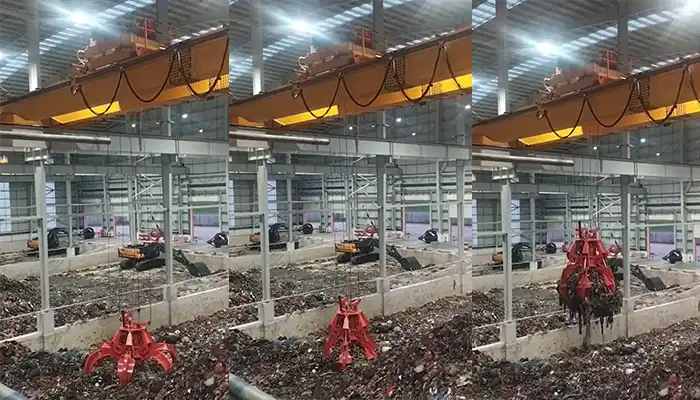
Supplied three grab bucket crane kits to Indonesia, enhancing garbage handling efficiency with high load capacity and reliable performance.
Free consultation to Confirm Parameters & Specifications and Get
Latest Crane Price & Crane Rate.
- Types of overhead cranes : _______?
- Optional: Overhead travelling crane, goliath gantry crane,Slewing jib crane, Single girder or double girder crane,small portable crane or kbk crane, etc.
- Capacity of overhead crane: _______?
- Optional: 0.25ton, 0.5 ton, 1 ton, 2 ton, 3ton, 5 ton, 10 ton,15ton, 20ton, 25 ton, 30ton,35ton, up to 550ton, etc.
- Crane span & lifting height : _______?
- Crane travelling length : _____?
- Control of overhead crane:_______?
- Optional: pendant/ remote/cabin control
- Voltage supply of overhead crane:_____?
- Eg,: 380V50/60HZ,3Phase or others,etc.
- Application/usage of crane:_______?
- Eg,: Steel mill, ,injection mold, cement,stone, concrete,granite, general manufacturing, etc.
Just leave a message via the contact form and our hoist and crane engineer will contact you with in 24working hours.
Get In Touch
